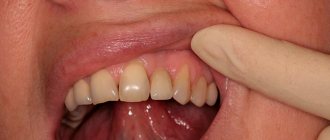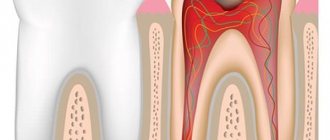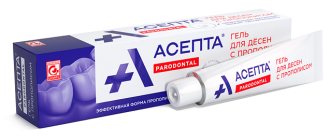The vast majority of the adult population of the planet is familiar with toothache. It can manifest itself in different ways, including when pressure is applied to a tooth, when a person cannot bite even soft food.
| Causes of pain and accompanying conditions | Methods for eliminating toothache |
| Increased sensitivity of the tooth in the absence of external damage, pain occurs even with slight pressure | At home: rinsing with herbal decoctions, soda solution When visiting a doctor: remineralization (treatment with preparations containing calcium and fluoride), in some cases - building up new enamel |
| Damage to enamel (cracks, chips - including microscopic ones invisible to the eye), the appearance of severe pain when exposed to any factor | It is recommended to consult a doctor |
| Inflammation of the gums: pain occurs when pressing on a healthy tooth precisely because of the condition of the gums | At home: rinse with a water-soda solution, sea buckthorn oil lotions. If there is no effect, you should consult a doctor. |
| Inflammation of the upper part of the tooth (periodontitis), accompanied by independent, precisely localized pain and a general deterioration of the condition | Treatment at home is impossible; you need to see a doctor. During the first week after removal: rinse |
| Removal of the nerve: after depulpation, pain may persist due to injury to the fibers (the reason is unskilled intervention that led to tissue necrosis due to insufficient asepsis of the canals) | The persistence (especially the intensification) of pain requires immediate contact with a doctor in case of a medical error |
| A complication of caries is pulpitis, intense pain that intensifies when chewing, discoloration of tooth enamel (graying) | requires immediate medical attention; if delayed, tooth loss may occur |
Pain when pressing on a tooth after treatment
Pain when pressing on a treated tooth is an absolute norm: any dental intervention has a traumatic effect on the gum tissue, recovery takes some time, but every day the pain weakens.
In patients with increased tooth sensitivity or a low pain threshold, the recovery process may take 1-2 months.
To alleviate the condition during this period, it is recommended:
- Thorough brushing of teeth using dental floss;
- rinsing (starting from the fourth day after treatment);
- use of painkillers.
Features of dental nerve removal
On a note! Upon completion of the manipulations, the doctor must evaluate the result. For control, an x-ray is taken again, from which the dentist makes a conclusion about the quality of treatment. After a properly performed operation, the pulpless tooth will serve the owner for many years and can even become a support for a prosthesis.
Why does pain occur after removal?
Experts identify several factors that cause pain in a sealed tooth without a nerve - this can be either a normal condition or a pathological one. To be able to distinguish them, you should know some nuances.
It is normal to feel painful discomfort in the first few days after visiting the dental office. Under the influence of the drill, healthy dental tissues heat up, hence the unpleasant sensations. Pain occurs with pressure or during eating - for one to three days or a week.
Important! Pain may be the result of a complication, injury, inflammation, or an error made by the doctor at some stage of treatment. If the pain does not go away even after two to three weeks or suddenly arises a few days after the procedure, especially at night, this is a reason to contact the clinic.
The dentist must determine the cause and prescribe treatment if necessary. The filling will likely need to be removed and the root canals re-treated. In any case, it is better not to delay going to a specialist.
Pain after dental treatment
The main causes of pain in the root of a tooth without a nerve are presented below.
1. Damage to periodontal tissue
When processing canals with special instruments, their edges may go beyond the border of the root and touch sensitive tissues. Also, unpleasant sensations can be caused by a small amount of antiseptic getting outside the root canal, which the dentist uses to disinfect the treated cavities. Such procedures involve the use of potent drugs, and their effects may well cause irritation. If the dentist did everything correctly, in both cases considered, the pain usually goes away after a few days.
2. Unsatisfactory canal filling
As a result, internal inflammation often develops, which is visible only on an x-ray. There are two possible reasons. First: the canals were not completely sealed. If during filling there are voids in the canal, areas that are not completely filled, over time harmful bacteria will begin to multiply in them, which will cause inflammation. The spread of infection can lead to the accumulation of pus at the root and the occurrence of periodontitis. The second reason suggests that the filling material has reached beyond the root apex, which also contributes to severe discomfort.
3. A piece of dental instrument remains in the root canal
During expansion, cleaning or filling, a piece of one of the devices could break off and get stuck in the canal. In most cases, this happens due to the fault of the doctor - if he violates the technique of working with the instrument. The exception is when the dentist deals with curved canals. Sometimes it is possible to get the piece out, but if it gets too deep, it will be impossible to remove it. The presence of a foreign object, even a tiny one, will prevent the specialist from performing the filling properly. This means that voids form in the canal, which will become a springboard for the proliferation of microbes and the occurrence of inflammation. Over time, it will spread to the periodontium, and if left untreated, to the jaw bone and soft tissues.
What to do with prolonged pain?
If you have a pain in a filled tooth without a nerve, and the pain does not go away within a few days, you should seek medical help. Most often, the problem can be solved, otherwise the dentist will suggest removing the affected unit of the dentition and installing an implant or dental bridge.
How does dental retreatment occur?
Depending on the cause of the ailment, there are several ways to relieve the patient of pain under a filling in a healed tooth without a nerve:
if the canals are not completely sealed, you will have to treat again - removing the old filling material and installing a new one. This must be done as quickly as possible, otherwise inflammation on the roots will lead to the loss of an incisor or molar. In addition, the specialist may decide to perform a surgical resection of the upper part of the root. Then there will be no need to carry out all the manipulations again if the filling material gets outside the canals: everything will depend on the amount of the substance. If there is only a small amount of it, the pain usually subsides naturally, and the tooth does not need to be re-treated. It is acceptable if mild discomfort continues for up to one to two months. Whether it is necessary to wait until the pain goes away on its own and treat immediately - this is decided by the doctor, focusing on the dynamics of the patient’s sensations. If the pain gradually disappears, it is likely that you will not have to repeat the manipulations.
If a lot of material gets outside the root, the doctor often performs an operation to cut off the tip of the root. To remove particles of filling material, the dentist makes a hole in the jawbone and removes excess material through it. It sounds scary, but in practice it is not the most difficult procedure. It lasts no more than an hour if a piece of the instrument remains in the canal: professional dentists try to remove the foreign body immediately after detection in order to prevent complications. The fragment is removed using ultrasound, the waves of which knock the particle out of the canal.
Another method involves creating a new channel close to the stuck debris. It is expanded, disinfected and the instrument is removed through it. It is also possible to use the method of resection of the root apex already described above and remove it along with the stuck piece if perforation has occurred: this is the most difficult case, requiring filling with a special expensive material. If the occurrence of perforations was caused by a dentist, the medical organization must correct the situation at its own expense.
Filling can be carried out both in the standard way - from inside the dental cavity, and from the outside, creating access to the perforated area through surgery, if an allergy to the filling material is detected: the patient can be relieved of pain only after repeating the treatment procedures with replacing the filling substance. Reaction to hot food: is this possible? There are known cases when hot food or drinks cause pain in a pulpless tooth. Normally, this should not happen, because the doctor removed the pulp, which made the unit of the dentition insensitive to thermal influences.
However, if particles of nerve tissue remain inside, sensitivity may persist and cause discomfort. Another scenario: inflammation from the pulp has spread further, and exposure to hot foods or liquids causes pain in these tissues. To accurately determine the cause, you should contact a professional. X-rays and examination using a special microscope will help identify the source of residual sensitivity.
Why complications arise
Deformation of tissues (even minimal chips of enamel) causes various complications, which is associated with the penetration of infections into the depths of the tooth. Among the most serious complications:
- abscess (can spread to several teeth or cover half the jaw);
- sinusitis, pharyngitis, sepsis;
- inflammation of the jaw bone;
- development of phlegmon (with damage to the facial muscles).
All these infections are fraught with penetration into the blood and disruption of the general condition of the body.
The most common complication is the development of caries, which, in the absence of adequate treatment, leads to complete destruction of the tooth with the need for its removal.
Causes
The circulatory system and… are responsible for such a specific manifestation of pain. gravity. When you lie on your side, blood flows under the influence of gravity to the lower part of the body (lower - in relation to the surface on which you are lying).
This causes the tissues of the lower body to become compressed by the blood flow. In good health, you will not even notice this “gravitational effect”, since it is compensated by intracellular pressure. But when inflammation develops in the tissues, they swell on their own. And the nerve fibers located in such a pathological focus are pinched and begin to signal pain. When pressure on the nerves increases due to blood flow, the signal correspondingly becomes even stronger.
The mechanism of pain, which appears only in a lying position (or sharply intensifies in a horizontal position) is the same for all inflammatory processes - it does not matter whether the ligaments are inflamed after an injury or the nasal mucosa during a runny nose.
But when such pain appears in a tooth, the causes may be the following diseases:
- acute or chronic pulpitis (inflammation of the pulp);
- periodontitis (inflammation of the supporting apparatus of the tooth);
- periodontitis (inflammation of the tissues surrounding the tooth root and root membrane);
- periodontal abscess (purulent formation at the root of a tooth);
- periostitis (inflammation of the periosteum of the jaw);
- tooth root cyst.
All of these diseases have one thing in common. They are accompanied or caused by inflammation of the tooth tissue or tissues surrounding the tooth, and the rush of blood to these areas leads to increased pain.
How to cope with pain?
Toothache is always a good reason to see a doctor; it’s worth taking the time to avoid complications!
If professional dental care is not possible, first aid is to relieve pain and minimize inflammation.
Analgesics of various effects used in dentistry - tempalgin, ketorol, nurofen; standard dosage regimen - 1-2 tablets every 4 hours; The effect of the drugs begins within the first 15 minutes and lasts up to 6 hours.
What you can do yourself
If the tooth hurts severely, and for some reason it is impossible to get an appointment with a doctor today, you should rinse with a saline or soda solution. Warming compresses should never be used - they often aggravate the inflammatory process and provoke blood poisoning.
For unbearable pain, you can take an over-the-counter analgesic available in your home medicine cabinet. But this should be a “one-time event”. As soon as possible, the patient should see an experienced dentist.
Rinse for painful sensations
Rinses are also widely used - both homemade and pharmacy. For example:
- 100 ml of water, a teaspoon of soda, a teaspoon of soda, iodine - 5 drops. Used to relieve swelling and remove purulent contents
- 1 spoon of sage per glass of boiling water (decoction), anise - 10 drops. Provides pain relief and has an anti-inflammatory effect.
- 1 glass of warm water, 1 tablet of furacillin. Powerful antibacterial effect, reducing swelling.
The drug chlorhexidine has a good aseptic effect; so-called dental elixirs can be used to relieve pain.
It is important to understand that all the methods listed above are only first aid for toothache; if you stop there, you will soon inevitably need tooth extraction!
To eliminate pain, it is necessary to identify and eliminate the cause of the problem. This can only be done in a dental clinic, where modern equipment ensures comfortable and painless treatment.
A tooth hurts under a temporary filling: treatment
After the filling is installed, you may experience some pain that goes away on its own within a few days. If there is significant discomfort, dentists recommend rinsing with a warm solution of furatsilin or chlorhexidine. A warm saline solution will also relieve pain. After eating, do not forget to rinse your mouth with warm water and 0.5 tsp. soda and a couple of drops of iodine. You can also apply a cooling gel or place a piece of ice on the tooth area. Painkillers can only be used as prescribed by a doctor.
In this case, it is highly not recommended to use traditional methods to relieve toothache under a temporary filling. Home remedies provide only temporary relief and do not eliminate the cause of the pain.
Treatment: when the cause of the pain is established
Having established the cause of the pain, the dentist will prescribe appropriate treatment.
The approach to treatment depends not only on the established cause of pain, but also on the neglect of the process (the degree of damage to the tooth and adjacent tissues).
- If increased tooth sensitivity is detected, remineralization or fluoridation is performed.
- The presence of chips and cracks requires composite enamel extension, or, as an option, the installation of veneers or crowns.
- In inflammatory processes, a course of treatment with antibiotics is usually prescribed with the installation of a filling after the source of inflammation has been eliminated.
- If the cause of pain lies in a poorly placed filling, it is polished or replaced with a new one.
- Detection of caries and pulpitis requires dental intervention such as preparation of the upper part of the tooth and opening of the cavity with the placement of medicine. After eliminating the infection, the dental canals are filled and the relief of the dentition is restored.
- Treatment of periodontitis is more complex; a specialist in such diseases is a dental surgeon. Drainage of the purulent cavity is performed, after the capsule is emptied of purulent contents, the canals are cleaned and the tooth is treated; in case of extensive lesions, resection of the root apex of the tooth is required.
Tartar
This disease manifests itself if oral hygiene is not observed. Due to improper removal of dental plaque or neglect of brushing the teeth, the plaque hardens and a brown plaque appears, which becomes impossible to get rid of on your own. To prevent tartar from appearing, you should perform thorough oral hygiene twice a day (morning and evening). Signs of stone formation include:
- Having bad breath;
- Itching and bleeding gums;
- There are dark spots on the enamel surface, which are very difficult to get rid of with a regular brush and paste.
The insidiousness of the stone is that it forms in the mouth on dentures, crowns, and not just on natural enamel. Of course, stone on crowns will not lead to caries, but it will contribute to the development of infections on the gums.
They turn to a doctor when it is problematic to remove tartar on their own. The dentist does the following:
- Using a hand tool or ultrasound, plaque and stone are removed;
- The surface of the teeth is polished;
- Surfaces are polished using ultrasonic tools and pastes with abrasive particles of varying degrees of dispersion.
Tartar is removed under local anesthesia - treatment with ice-caine spray is sufficient.











